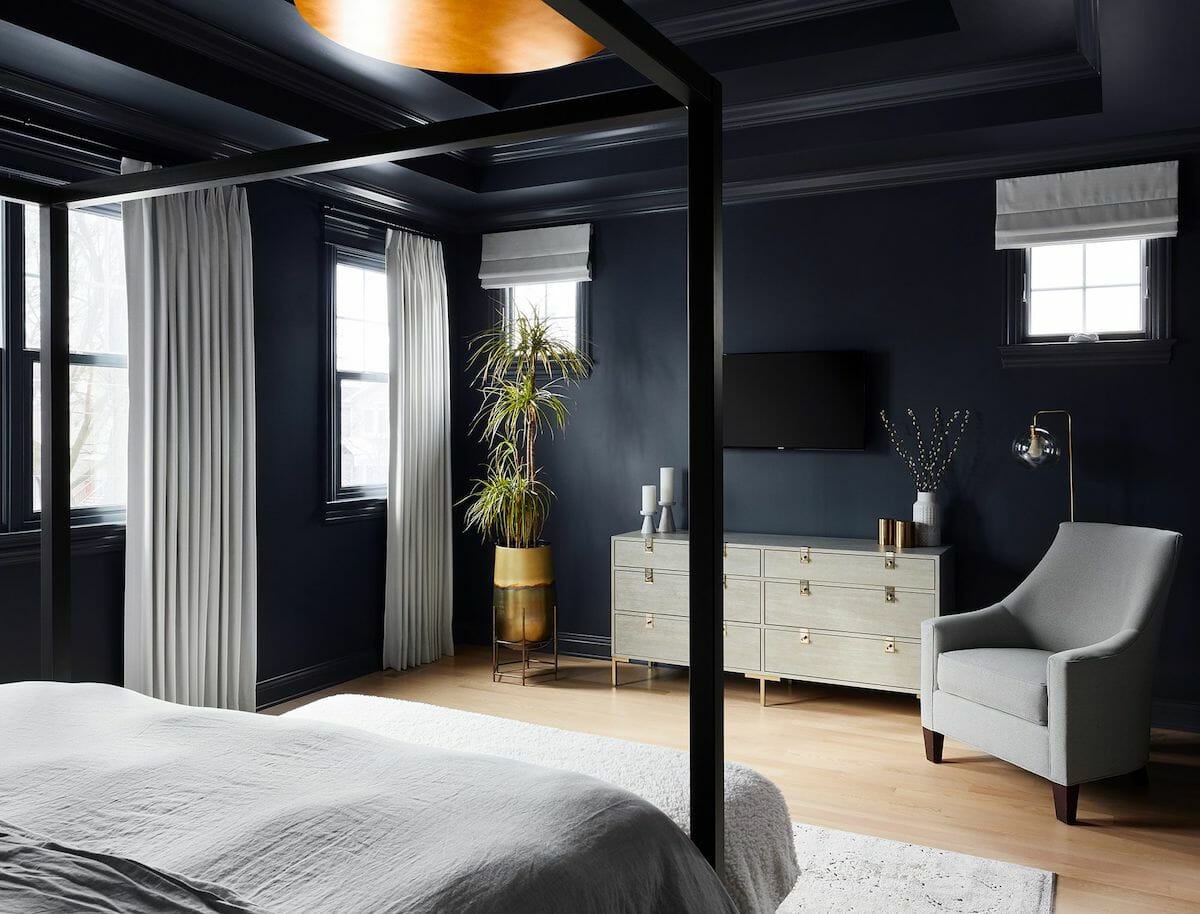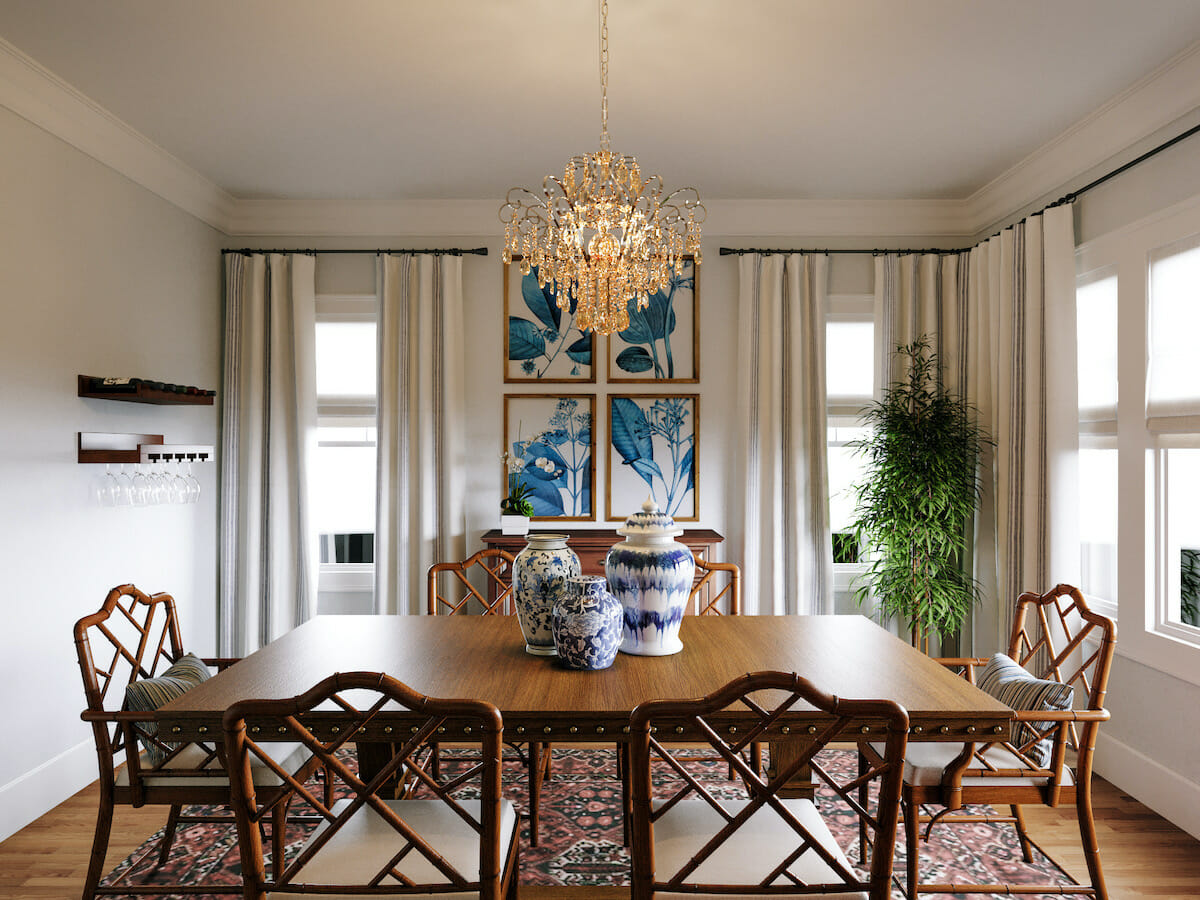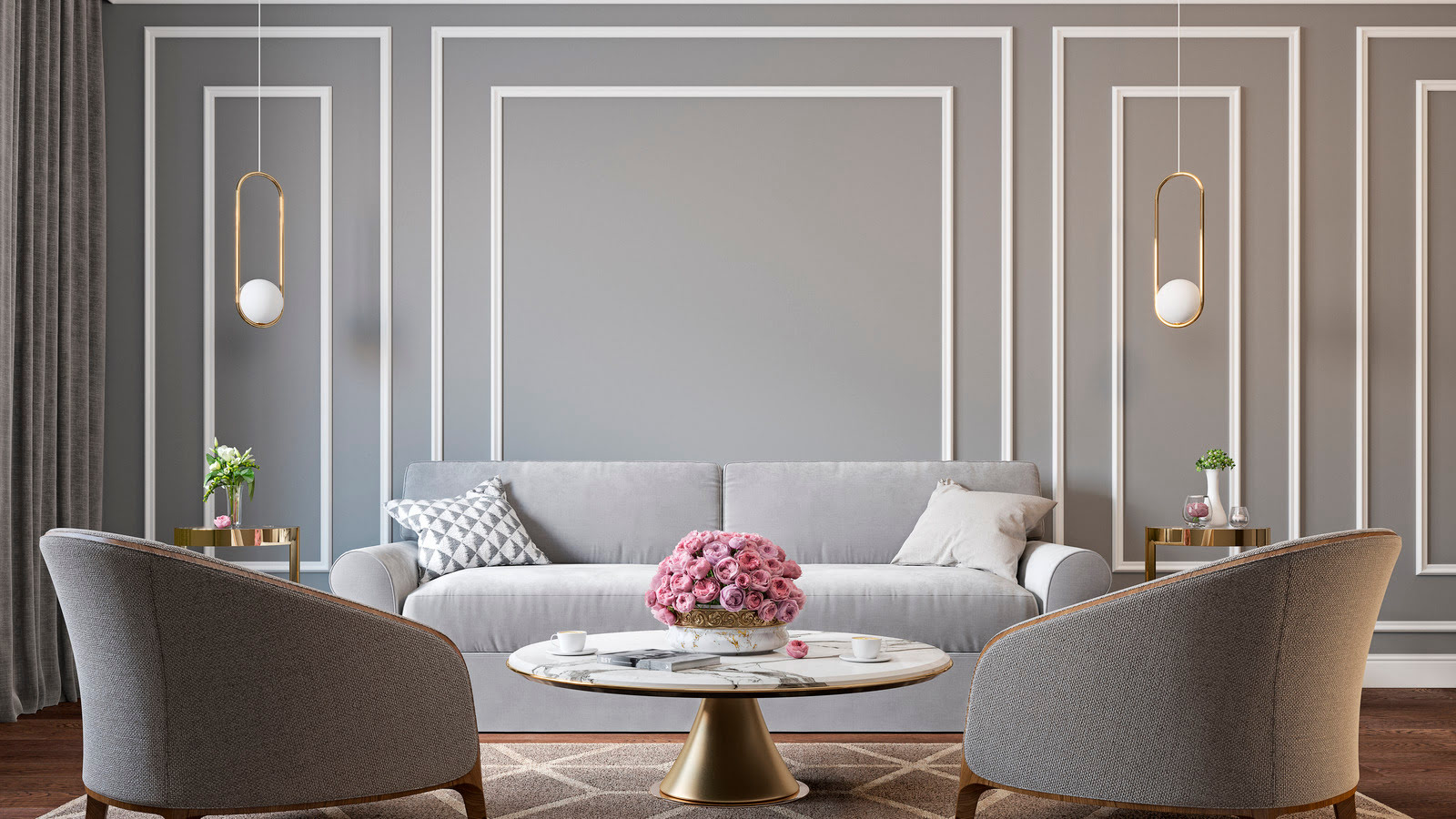

Articles
What Does A Black Ceiling Do For A Room
Modified: January 23, 2024
Discover the transformative power of a black ceiling in your room. Read our articles to learn how this simple change can elevate your space with sophistication and style.
(Many of the links in this article redirect to a specific reviewed product. Your purchase of these products through affiliate links helps to generate commission for Storables.com, at no extra cost. Learn more)
Introduction
A black ceiling is an unconventional yet striking design choice that can have a transformative effect on a room. While traditionally, ceilings are painted white to create an illusion of height and space, a black ceiling can bring a unique aesthetic and character to any space.
When you think of a black ceiling, you might envision a dark and oppressive space. However, when used correctly, a black ceiling can actually have several benefits and add a touch of sophistication to a room.
In this article, we will explore the concept of a black ceiling and delve into the various advantages it offers. We will also discuss the considerations you should keep in mind when implementing a black ceiling and touch upon potential drawbacks.
Key Takeaways:
- Embracing a black ceiling can create depth, drama, and elegance in a room, transforming the ambiance and adding a touch of sophistication to the space.
- Careful consideration of room size, lighting, and color coordination is essential when implementing a black ceiling, ensuring a visually captivating and harmonious design.
Read more: What Does Black Candles Mean
Definition of a Black Ceiling
A black ceiling refers to the practice of painting or covering the ceiling in a room with a black color or material. It deviates from the traditional approach of painting ceilings in lighter shades, such as white or off-white.
The use of a black ceiling can dramatically alter the look and feel of a room, creating a bold statement and adding a sense of depth and drama to the space. It can be implemented in various types of rooms, including living rooms, bedrooms, dining rooms, offices, and even commercial spaces like restaurants and bars.
While painting the ceiling black is the most common method, other alternatives can achieve a similar effect. For instance, using black tiles, black acoustic panels, or installing black ceiling boards can all contribute to achieving a black ceiling aesthetic.
The overarching idea behind a black ceiling is to create a visual contrast and make a room stand out. It can be considered an unconventional design choice for those who seek to break away from traditional norms and add a touch of creativity and sophistication to their living or working environment.
Now that we have a clear understanding of what a black ceiling entails, let’s explore the advantages it brings to a room and why it is an option worth considering.
Benefits of a Black Ceiling in a Room
Implementing a black ceiling in a room can have a profound impact on the overall ambiance and aesthetic. Let’s explore some of the key benefits:
1. Creates a Sense of Depth
A black ceiling has the ability to visually lower the height of a room, creating a cozy and intimate atmosphere. This effect can be particularly desirable in rooms with high ceilings or large open spaces, as it helps to bring the focus downwards and make the space feel more intimate and connected.
2. Enhances the Ambiance
The use of a black ceiling can help create a specific mood or ambiance in a room. It can evoke a sense of elegance, drama, and sophistication. Depending on the style and furnishings of the room, a black ceiling can add a touch of luxury or create a sleek and modern aesthetic, making it a versatile choice for various design preferences.
Read more: What To Do When Ceiling Collapses
3. Adds Drama and Elegance
A black ceiling can instantly transform a room into a stylish and chic space. It serves as a captivating focal point, drawing attention upwards and adding an element of drama to the overall design. When paired with appropriate lighting fixtures and decorative elements, a black ceiling can create a sense of grandeur and elegance.
4. Hides Imperfections
In some cases, ceilings may have noticeable imperfections such as cracks, blemishes, or uneven surfaces. By painting the ceiling black, these imperfections can be effectively camouflaged. The dark color masks minor flaws and creates a seamless appearance, minimizing the need for extensive repairs or renovations.
5. Increases Focus on Other Elements
A black ceiling can help draw attention to other design elements in the room. Whether it’s a statement artwork, vibrant furniture, or an eye-catching chandelier, a black ceiling provides a contrasting backdrop that allows these elements to stand out and become the center of attention.
By leveraging these benefits, a black ceiling can elevate the overall aesthetic of a room and create a visually captivating space.
Creates a Sense of Depth
A black ceiling has the remarkable ability to alter our perception of space and create a sense of depth in a room. While traditionally, a lighter-colored ceiling is used to give the impression of a taller, more spacious environment, a black ceiling can have the opposite effect by visually lowering the ceiling height.
This can be particularly advantageous in spaces with high ceilings or large open areas where a sense of intimacy and connection is desired. By bringing the focus downwards, a black ceiling helps to create a cozy and inviting atmosphere, making the room feel more grounded and intimate.
Imagine a room with a black ceiling and walls. The dark color overhead gives the illusion that the ceiling is closer to us, enclosing the space and creating a feeling of being embraced by the room. This can be especially appealing in bedrooms, living rooms, or dining areas where a snug and cozy ambiance is desired.
Additionally, a black ceiling can also create a captivating contrast with the walls and flooring, further accentuating the sense of depth. For instance, if the walls are painted in lighter shades, such as white or neutral colors, the dark ceiling draws the eyes upwards, creating a visually striking effect.
However, it’s important to note that the impact of a black ceiling in creating a sense of depth may vary depending on the size and design of the room. In smaller rooms, a black ceiling can potentially make the space feel more closed-in and claustrophobic. In such cases, it’s advisable to strike a balance by incorporating other design elements that can enhance the perceived depth, such as strategic lighting techniques or the use of mirrors to reflect light and create an illusion of more space.
Overall, a black ceiling’s ability to create a sense of depth adds a unique and visually appealing element to a room, making it a compelling choice for those who want to make a bold design statement and transform their space into a more intimate and captivating environment.
Enhances the Ambiance
A black ceiling has the power to significantly enhance the ambiance of a room, creating a unique and captivating atmosphere. The dark and rich color brings a sense of depth and sophistication that can transform an ordinary space into a visually striking and memorable one.
One of the key advantages of a black ceiling is its ability to evoke a specific mood or style. It exudes a sense of elegance, drama, and even a hint of mystery. When combined with the right elements, such as furniture, lighting, and accessories, a black ceiling can help create a cohesive and visually appealing ambiance that resonates with your desired aesthetic.
For instance, in a modern and minimalist design scheme, a black ceiling can add a sleek and contemporary touch. It provides a bold backdrop against which clean lines and minimalist furnishings can shine. Pairing it with metallic accents or pops of color can further enhance the modern ambiance.
In contrast, in a more traditional or vintage-inspired interior, a black ceiling can add a touch of old-world charm and opulence. By incorporating ornate chandeliers, luxurious fabrics, and rich textures, the black ceiling becomes a dramatic and elegant focal point that elevates the entire space.
Mood lighting also plays a vital role in enhancing the ambiance created by a black ceiling. The right lighting fixtures can cast a warm and inviting glow, creating an intimate and cozy atmosphere. Recessed lighting or pendant lights can be strategically placed to illuminate specific areas and highlight architectural features, adding to the overall allure of the room.
It’s important to note that the choice of furnishings and décor should be carefully considered when implementing a black ceiling. A well-coordinated color scheme and the right balance of textures can harmonize the space and contribute to the desired ambiance. Additionally, incorporating natural light through windows or skylights can help to balance the dark ceiling and prevent the room from feeling too enclosed.
By skillfully leveraging the power of a black ceiling to enhance the ambiance, you can create a space that not only looks visually stunning but also evokes the specific mood and atmosphere you desire.
Adds Drama and Elegance
One of the most notable benefits of incorporating a black ceiling in a room is the instant dose of drama and elegance it brings to the space. The striking contrast created by the dark ceiling against lighter-colored walls or furnishings creates a visually captivating and memorable aesthetic.
A black ceiling serves as a bold statement piece, drawing immediate attention and becoming a focal point in the room. It exudes a sense of sophistication and opulence, elevating the overall ambiance and making a strong design statement.
When combined with the right elements, such as chic lighting fixtures, luxurious fabrics, and tasteful accessories, a black ceiling can enhance the overall drama and elegance of the room. Crystal chandeliers or sleek pendant lights hanging from a black ceiling create a captivating contrast and add a touch of glamour and refinement.
In addition, the dark color of the ceiling can create an intimate and cozy atmosphere, particularly in areas where relaxation and comfort are desired, such as bedrooms or living rooms. The feeling of being enveloped by the rich darkness creates a sense of privacy and tranquility, adding to the overall elegance of the space.
To further enhance the dramatic impact of a black ceiling, consider incorporating accent lighting. Strategic placement of spotlights or track lighting can create dramatic pools of light against the dark backdrop, accentuating specific areas or objects and adding depth to the room.
It’s important to strike a balance when using a black ceiling to add drama and elegance. Incorporating lighter shades, textures, or patterns in the walls, flooring, or furnishings can help prevent the room from feeling too heavy or overpowering. Introducing pops of color through artwork or decorative accents can also add a lively contrast against the dark backdrop.
Overall, a black ceiling brings an undeniable sense of drama, elegance, and sophistication to any room. By carefully selecting complementary elements, lighting, and color schemes, you can create a truly stunning and visually captivating space that exudes refined style and charm.
Hides Imperfections
One of the practical advantages of implementing a black ceiling in a room is its ability to effectively conceal imperfections. In many spaces, ceilings can often show signs of wear and tear, such as cracks, stains, or uneven surfaces. Painting the ceiling black can be a clever solution to hide these flaws, as the dark color helps to mask minor imperfections and create a seamless appearance.
The reflective properties of lighter-colored ceilings tend to accentuate any flaws or irregularities, drawing attention to them. However, a black ceiling has the opposite effect. The dark color absorbs light, making it more forgiving and less prone to showcasing blemishes or surface inconsistencies.
While a black ceiling may not magically fix major structural issues in the ceiling, it can significantly minimize the visibility of minor imperfections, providing a visually clean and cohesive look to the room. This can save you time, effort, and money that would otherwise be spent on extensive repairs or renovations to fix the ceiling’s flaws.
Additionally, a black ceiling can also aid in creating a sense of uniformity throughout the room. If there are differences in ceiling heights or textures between different sections of the room, painting the entire ceiling black can help to visually unify the space and make it appear more consistent.
It’s worth noting that proper surface preparation is crucial before painting a black ceiling to achieve the desired effect. Any loose paint, debris, or uneven areas should be addressed and smoothed before applying the black paint. This ensures a smooth and flawless surface that enhances the concealment of imperfections.
By choosing a black ceiling, you can effectively minimize the visibility of minor ceiling flaws and create a seamless, clean, and visually appealing aspect to the room.
Increases Focus on Other Elements
One of the unique advantages of incorporating a black ceiling in a room is its ability to divert attention and increase the focus on other elements within the space. By providing a visually striking backdrop, the black ceiling allows other design elements to take center stage.
When entering a room with a black ceiling, the eyes are naturally drawn upwards towards this bold and contrasting element. This visual contrast creates a captivating effect and shifts the attention towards other aspects of the room, such as furniture, artwork, or architectural features.
For instance, imagine a room with a stunning piece of artwork on the wall. With a black ceiling, the artwork becomes even more prominent and visually impactful. The dark backdrop of the ceiling creates a stark contrast against the artwork, making it the focal point and enhancing its aesthetic appeal.
The same concept applies to other design elements as well. A beautifully designed piece of furniture, a unique lighting fixture, or a decorative accent can all become more prominent and visually captivating when placed within a room with a black ceiling.
Moreover, a black ceiling can also create a sense of depth and dimension, further enhancing the focus on other elements. The contrast between light-colored walls and a dark ceiling draws the eyes upwards, creating a vertical visual flow that makes the room feel more dynamic and visually interesting.
When utilizing a black ceiling to highlight other elements, it’s important to consider the balance and coordination of colors and textures within the space. The other elements should complement the dramatic backdrop while still maintaining a cohesive and harmonious overall design. The strategic use of lighting can also play a significant role in directing attention and accentuating specific areas.
By using a black ceiling as a powerful visual backdrop, you can create a captivating atmosphere and heighten the focus on other key design elements, resulting in a visually engaging and memorable space.
Considerations When Using a Black Ceiling
While a black ceiling can bring a unique and visually striking element to a room, there are several considerations to keep in mind to ensure a successful implementation. These factors include room size and design, lighting options, and color coordination.
1. Room Size and Design
The size and design of the room are important factors to consider when opting for a black ceiling. In smaller rooms, a black ceiling can create a more enclosed and intimate feel, which may or may not be desirable depending on your preferences and the purpose of the room. It’s essential to assess how a black ceiling will impact the overall proportions and functionality of the space.
Additionally, consider the existing design scheme and architectural features of the room. A black ceiling may work better in rooms with high ceilings, as it can create a more balanced and visually appealing effect. In rooms with low ceilings, a black ceiling can potentially make the space feel even smaller and more cramped.
2. Lighting Options
Proper lighting is key when implementing a black ceiling. The dark color of the ceiling can absorb light, making the room appear darker than it actually is. Therefore, it’s crucial to consider the lighting options available to ensure sufficient illumination and prevent the room from feeling too dim or gloomy.
Strategic placement of lighting fixtures, such as recessed lights, track lighting, or pendant lights, can help to provide adequate lighting and highlight specific areas or architectural features. Additionally, incorporating natural light through windows, skylights, or light-colored walls can help to balance the darkness of the black ceiling and create a more inviting and well-lit space.
3. Color Coordination
When opting for a black ceiling, it’s essential to consider the overall color scheme and coordination within the room. The black ceiling will create a strong visual contrast against lighter-colored walls or furnishings, which can be visually striking if done correctly. However, it’s important to ensure that the colors and textures within the room complement each other and create a cohesive and harmonious design.
Consider the use of other colors, patterns, and materials in the space to create a balanced and visually appealing ambiance. Incorporating contrasting or complementary colors through furniture, accessories, or wall artwork can help to tie the room together and prevent the black ceiling from feeling overwhelming or disconnected.
By taking these considerations into account, you can ensure that a black ceiling is implemented successfully and adds a unique and visually captivating element to the room.
Room Size and Design
When considering a black ceiling for a room, one crucial factor to consider is the size and design of the space. The impact of a black ceiling can vary significantly depending on the room’s dimensions and existing architectural features.
For larger rooms with high ceilings, a black ceiling can create a dramatic and cohesive look. The dark color can help to visually lower the ceiling height, creating a more intimate and cozy atmosphere. It can also add a touch of elegance and sophistication, making the room feel more refined and luxurious.
On the other hand, in smaller rooms with lower ceilings, a black ceiling may not be the most suitable choice. It can make the space feel more enclosed and potentially diminish the sense of openness. In such cases, it’s important to consider alternative options to prevent the room from appearing cramped and stifling.
It’s also essential to consider the existing design elements in the room. A black ceiling can complement contemporary or modern design schemes, adding a sleek and sophisticated touch. In contrast, it may not align well with more traditional or rustic styles, where lighter-colored ceilings are often favored to create a sense of lightness and airiness.
Additionally, consider how the black ceiling will interact with the overall color palette of the room. If the walls and other surfaces are already predominantly dark or bold in color, a black ceiling may create a visually overwhelming effect. However, if the room features lighter-colored walls and furnishings, a black ceiling can serve as a striking focal point and create a sense of contrast.
When deciding on a black ceiling, it’s important to assess the room size, architectural elements, and design style to ensure that it will enhance the overall aesthetics and functionality of the space. By carefully considering these factors, you can create a harmonious and visually pleasing environment.
Lighting Options
Choosing the right lighting options is crucial when implementing a black ceiling in a room. The dark color of the ceiling can absorb light, potentially making the space feel dim or gloomy if not properly illuminated. Therefore, it’s important to consider different lighting techniques to ensure sufficient brightness and enhance the overall ambiance.
One effective lighting option for rooms with a black ceiling is recessed lighting. These fixtures are installed directly into the ceiling and provide a clean and subtle source of illumination. Placing recessed lights strategically throughout the room can help evenly distribute light and prevent any areas from appearing too shadowy or dark.
An alternative option is track lighting, which consists of multiple adjustable light fixtures mounted on a track. Track lighting can be directed towards specific areas or objects, allowing for greater control and flexibility in lighting the space. This can be particularly useful in highlighting artwork, displays, or specific architectural features.
Pendant lights can also be a great choice for rooms with a black ceiling. These hanging light fixtures can add a decorative element while providing focused lighting in specific areas. Pendant lights can be used to create stylish visual interest and balance out the darkness of the ceiling.
It’s worth noting that natural light can also play a significant role in complementing a black ceiling. Incorporating ample windows, glass doors, or skylights can introduce natural light into the room, balancing out the darkness of the ceiling and creating a more inviting and well-lit environment during the daylight hours.
Additionally, considering the integration of accent lighting can further enhance the ambiance of a room with a black ceiling. Accent lighting can be used to highlight specific features, such as artwork, architectural details, or textured elements on the walls. This can help create depth and add visual interest to the space.
When selecting lighting options for a room with a black ceiling, it’s crucial to strike a balance between functionality and aesthetics. Creating a well-lit environment that complements the dark ceiling will ensure the overall space feels inviting, visually appealing, and cohesive.
Color Coordination
When using a black ceiling in a room, it’s essential to carefully consider color coordination to create a cohesive and visually pleasing space. The combination of the black ceiling with the other elements in the room, such as the walls, furniture, and decor, can greatly impact the overall aesthetic.
One aspect to consider is the color of the walls. Lighter-colored walls, such as whites, off-whites, or soft neutrals, can provide a striking contrast against the black ceiling. This contrast can create a visually interesting and dynamic look, drawing attention to both the ceiling and the walls. On the other hand, darker-colored walls may result in a more monochromatic and dramatic effect, where the black ceiling blends with the walls, creating a sense of cocooning and intimacy.
In terms of furniture and decor, consider incorporating colors that either complement or contrast with the black ceiling. Lighter-colored furniture and accessories can provide a pop of contrast against the dark ceiling, creating visual interest and preventing the space from feeling too heavy. Alternatively, you can opt for furniture and decor in darker shades that harmonize with the black ceiling, resulting in a more cohesive and unified interior design.
The use of patterns and textures should also be taken into account. Incorporating patterns with contrasting colors can add visual interest and depth to the room. For example, a black and white patterned rug or textured wallpaper can create a striking visual impact against the black ceiling. Playing with textures such as velvet or faux fur can add warmth and dimension to the space.
It’s important to note that color coordination extends beyond just the ceiling, walls, and furnishings. Consider how the colors of the flooring, window treatments, and other decorative elements will interact with the black ceiling. The goal is to create a cohesive color palette that complements and enhances the overall design.
Ultimately, the key to successful color coordination with a black ceiling is to create a balance between contrast and harmony. By carefully selecting colors and textures that work well together, you can create a visually pleasing and harmonious space that showcases the unique beauty of the black ceiling.
Potential Drawbacks of a Black Ceiling
While a black ceiling can bring many benefits and create a visually stunning impact in a room, it’s important to consider the potential drawbacks before making the decision to implement one. Here are a few factors to keep in mind:
Read also: 13 Best Black Ceiling Fan for 2025
1. Perception of Space
A black ceiling has the tendency to visually lower the height of a room and create a more enclosed feel. While this can be desirable in certain spaces, such as bedrooms or cozy living areas, it may not be ideal for rooms that already have low ceilings or limited space. In such cases, a black ceiling can make the room appear even smaller and potentially feel more confined.
2. Lighting Considerations
The dark color of a black ceiling absorbs light, which means that proper lighting becomes crucial to prevent the space from feeling too dim or gloomy. It’s necessary to carefully plan and implement adequate lighting options, such as recessed lighting or track lighting, to ensure that the room remains well-illuminated. Without proper lighting, a black ceiling can make a room feel overly dark or cavernous.
3. Dust and Maintenance
Dark surfaces, including a black ceiling, have a tendency to show dust, lint, and other particles more prominently than lighter-colored surfaces. This means that regular cleaning and maintenance may be necessary to ensure that the ceiling remains clean and free from dust buildup. It’s important to consider this aspect, especially in rooms where dust accumulation is more likely, such as kitchens or areas with high foot traffic.
4. Limited Color Schemes and Design Options
The use of a black ceiling can potentially limit the color schemes and design options for a room. The strong visual presence of a black ceiling may require more careful consideration when choosing furniture, decor, and other elements to ensure a harmonious and cohesive look. It’s important to carefully select colors and patterns that work well with the black ceiling, which can limit certain design choices and flexibility.
Read more: What To Do For Kids’ Room Decoration
5. Perception of Temperature
Dark colors are known for their ability to absorb heat. As a result, a black ceiling may contribute to the perception of a warmer room, especially in spaces with limited airflow or higher ambient temperatures. This may not be ideal in climates or seasons when maintaining a cooler environment is a priority. It’s important to consider the impact of a black ceiling on the overall temperature and comfort of the room.
While these potential drawbacks should be considered, they do not diminish the impact and allure of incorporating a black ceiling. With careful planning and consideration of the specific room and its requirements, the drawbacks can be mitigated, allowing for a successful and visually stunning design choice.
Conclusion
Implementing a black ceiling in a room is a bold and striking design choice that can transform the ambiance and visual appeal of the space. While it may not be suitable for every room or design style, a black ceiling offers several benefits that can create a truly captivating environment.
The benefits of a black ceiling include the ability to create a sense of depth, enhance the ambiance, add drama and elegance, hide imperfections, and direct focus to other elements within the room. These advantages are particularly impactful when the surrounding design elements are carefully coordinated and lighting is thoughtfully planned.
However, it’s important to consider the potential drawbacks of a black ceiling, such as its impact on perceived space, the need for proper lighting, upkeep, limited color schemes, and the potential perception of temperature. By understanding and addressing these considerations, you can ensure that a black ceiling is implemented successfully and enhances the overall aesthetic of the room.
Whether you choose to incorporate a black ceiling as the focal point of a room or as part of a broader design concept, it is an option that adds a touch of sophistication, depth, and visual interest. With thoughtful planning and attention to detail, a black ceiling can create a truly memorable and captivating space that reflects your unique style and design preferences.
In the end, the decision to use a black ceiling is a personal one, guided by your individual taste and the specific requirements of the room. If executed thoughtfully, a black ceiling can elevate the overall design, create an intimate and visually striking ambiance, and make a powerful design statement.
So, consider the advantages and potential drawbacks, assess the room size and design, lighting options, color coordination, and make an informed decision. With careful planning and creative execution, a black ceiling can truly be a transformative element that adds depth, drama, and elegance to any room.
Frequently Asked Questions about What Does A Black Ceiling Do For A Room
Was this page helpful?
At Storables.com, we guarantee accurate and reliable information. Our content, validated by Expert Board Contributors, is crafted following stringent Editorial Policies. We're committed to providing you with well-researched, expert-backed insights for all your informational needs.










0 thoughts on “What Does A Black Ceiling Do For A Room”